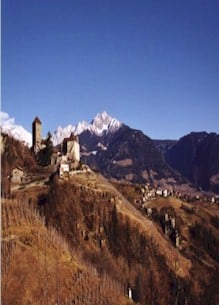Dear Guilford College,
Stop reading for a minute and take a look around you. What do you see? Your dorm room? The cafeteria? Good old Guilford…
Now imagine if this view were replaced by one of a medieval castle, a terraced vineyard, a mountain village, and, as a backdrop to it all, the snow-capped peaks of the Alps. Right now, there are 14 Guilford students living in Brunnenburg Castle, just outside of Dorf Tirol, Italy. This is what we see every day.
“Every time I look outside, I get kind of giddy,” said sophomore Emily Hatch. When was the last time you felt giddy just because you looked out your window? Perhaps some of you, reading this letter, have friends among the current Brunnenburg group. Perhaps some of you are still considering plans to study abroad. Perhaps you are one of the lucky few who have returned from a previous semester at the castle. Or perhaps you simply enjoy hearing stories about adventures in foreign lands. In any case, what follows is an attempt to describe the indescribable — to put into words the wonder of a semester in Brunnenburg.
Our story actually begins with a week in Munich, Germany, where the 14 of us met up with our faculty advisors, Jim and Martha Cooley. Although the South Tirol is a part of Italy today, its history is such that the people of the region speak, for the most part, a dialect of German. We had seven days to become fluent.
“Munich is even better than Greensboro,” said junior Coleman Watts, who enjoyed sampling traditional German foods and drinks when he was not studying his verb conjugations.
“Starting off in Munich was a really good idea,” said junior Brita Helgesen. “It gave us a chance to get to know each other outside of the situation we would be living in.”
In addition, the group made sure to explore the important historical and cultural traditions of the city, including the Lenbach Haus art gallery, Dachau, and several beer halls. At the end of the week, with many promises to return, we climbed on a bus and headed south over the Alps.
From the very first glimpse, Schloss Brunnenburg, the castle which we now call home, was something that none of us will ever forget.
“It’s a CASTLE! And we LIVE here!” said sophomore Stephanie Innes, who expressed frustration while attempting to put into words the full significance of that statement.
“Sometimes it feels like I’m in a dream,” agreed sophomore Elizabeth Baltaro. “This is something that I might have looked at pictures of in a book, and now here I am standing right in the middle of it. You can’t write home about it. You’re like, ‘Dear Mom and Dad, it’s really pretty here…’ but that doesn’t even begin to describe it.”
“You can’t imagine it…you just have to come see it. It’s like the eighth wonder,” added junior Elise Foster.
It seems that no one can really express the incredible beauty of the South Tirol … but don’t worry, that’s why we all brought cameras.
What is it that students in Brunnenburg do when we aren’t staring, wide-eyed, at the scenery? Well, that depends on the day. Although they are sometimes overshadowed by more novel experiences, we do actually take classes on Mondays, Wednesdays, and Thursdays. The majority of these are taught by two permanent residents, Mary de Rachewiltz and her son, Siegfried de Rachewiltz. One, which changes each year, is taught by the visiting Guilford professor.
“Sizzo,” or Professor Siegfried de Rachewiltz, “is the most interesting professor I’ve ever had,” said sophomore Aidan Hancock.
Junior Nicky Blanchard agreed. “[Sizzo and Mary] are amazing and that makes class good.”
“They’re the kind of people you see in movies,” said sophomore Andrew Hoffman. “You don’t actually meet people like that, you know?” But in Brunnenburg, you do. And you learn from them.
Classes in Brunnenburg are taught in a way that would simply not be possible in the United States. Not only does walking to class each morning involve descending a spiral staircase into what used to be the dungeon, but lectures are supplemented by frequent field trips and hands-on learning.
For example, a recent lesson in history and symbolism was held in the village of Tramin, where a bi-annual end of winter celebration called Egetmann has been held every February since the Middle Ages. “It was interactive insanity,” said sophomore Chris Poole. “And now we all feel very fertile.”
The festival was mentioned by several students as the highlight of the trip thus far, and described by sophomore Ryan Taylor as “surreal … it’s a real festival, not cleaned up by corporate America or any notions of political correctness.” The Egetman is one example of so many things which cannot be captured in books, lectures, or even photographs. You just have to see it to understand.
And then, of course, there is the ultimate experience in hands-on learning—working in the vineyard. “You can only learn so much about agriculture through lectures,” said Helgesen. And Sizzo is determined that every student who takes his class his will learn more than “only so much.”
Work day is one aspect of the Brunnenburg semester which distinguishes it from other study abroad programs. Once a week, rather than going to regular classes, the group helps out in the vineyards and gardens surrounding the castle. So far, the current group has shovelled dirt, thrown rocks down the side of the mountain, collected and stacked piles of firewood, rebuilt terraces destroyed by rain, turned over dirt in the herb and vegetable plots, cleared brush and nettles, gathered huge piles of vine clippings, and generally gotten ourselves very tired, dirty, and sore. But for some, Tuesday is the best day of the week. “I like that I’m tired at the end of the day,” said Hatch. “It’s actual honest work, and you can see what you’ve done. You feel like you’ve conquered something.”

